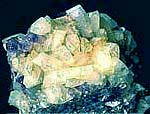Catalogue and magic properties of the stone -->rus
Euclase
 Description characteristic of the mineral.
Description characteristic of the mineral.
Silicate of aluminium and beryllium, be found as small crystals: colourless, chlorine, dark blue, bluish-green, chlorine, yellow and rarely - emerald-green. Stone reminds opal by appearance (which never be found in crystals). Euclase - very beautiful stone, rarely meeting and sufficiently by a road. In private collections this mineral meeting is difficult. It is better to charge diagnostics and determination of this mineral specialists (mineralogist).
Euclase belongs to the in current the use not minerals. Strong brilliance, beautiful color, high enough hardness - on these signs he would take the deserving place among the dearest jeweller stone. But, unfortunately, Euclase possesses large fragility (on Russian Ural he is named by "fragile") and perfect cleavage (on Greek well fissioning), that does him extremely uncomfortable material for cutting. The size of crystals of Euclase is usually small: as a rule, no more than 3 mm, rarer to 1,5 sm. Separate stone were used for cutting only from Brazil and from Russian Ural. A most fame is used by stone from Brazil. Mainly the crystals of Euclase are decorated by collections of mineralogical museums of the world. Euclase, especially in the cut kind, in color and alike some physical properties on Beryl (especially Aquamarine), phenacite, cyanite, Chrysoberyl.
In nature Euclase be found as lamellar-prismatic, lamellar, short- and longprismatic crystals with the large number of verges. The number of simply-shaped, known on the crystals of Euclase, is very great. Transparent crystals of Euclase can be colourless or dark blue, blue, bluish-, sky- and chlorine. At a friction electrified. In some crystals there is the uneven zonal colouring with colourless or rather yellow and intense-coloured areas. A zonality is possible also in spherulite and sheaf-like aggregates which on periphery are sometimes painted in a bright-blue color, and in a center almost colourless.
Magic properties of stone.
It is a talisman of people of experimental, living much interesting situations, able to do correct conclusions and study not only on own experience but also on experience other. Opens such people of Euclase many prospects, provides with their yet greater penetrating, but he is quite unavailing young and inexperienced people. Euclase mightily feeds the proprietor energy and helps to send it in a structural river-bed. Stone is an excellent talisman of practicing magicians and "magicians" of the most different type.
It is considered that this stone a few similar on the descriptions with an opal, at least, in a that value, as both these the stone operate on illusions, impedimental development and distracting a people. Euclase - stone the same dangerous, but dangerous only for young people. It stone of mature people.
It is considered that he renders the positive affecting only people, attaining century of Jupiter (45 years). And he distracts youths, wakes up anarchic inclinations, too large requirement in freedom. It stone of mature people. A strong man can wake up force of stone only. Euclase waking up very hardness Mohs. It well affects old men, when a people already can to give tradition and can pawn bases of family.
Any of stone is used in magic, but cleanly there is a little bit of magic stone. Euclase is one of them. It is elusive and changeable. The best of all he operates on those people, which he is passed to on an inheritance or given a present a very near on a spirit people, near other etc. It is here needed to watch after his energies. By Euclase go out on dyings ancestors and work with them.
Poisonous and radioactive risky hazardous cargo stone and minerals
** - are poisonous stone and minerals (mandatory verification is in the chemical analysis laboratory + on toxicity)
** - are radioactive stone and minerals (mandatory verification on a regular dosimeter + prohibition on the opened sales in the case of radio-activity over 24 milliroentgens / hour + additional measures of protection of people)
All of rare stone are subject obligatory verification on a regular dosimeter on the possible level of radiation and in a chemical laboratory on absence default of poisonous and evaporating components, dangerous for a human people and environment nature
- Free download article Very dangerous and potentially dangerous stone and minerals are in Medical stone therapeutics, with pictures, 2010 year, format of PDF, 2.80 Mb (Presentation from scientific of author K.305 of pictures of very dangerous and potentially dangerous natural stone and minerals which on a bad motive or criminal indifference can be illegally used in criminal and "underground" "Medical stone therapeutics"). Rus langv.
A catalogue of stone is all of stone in alphabetical order
- Signs of travelling traffic lane markings - to transportation and marking of dangerous load Policy Rules
- Rules of Road Transportation of Especially Dangerous Loads, Hazardous cargo commodity, signs index plate
